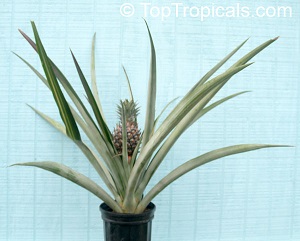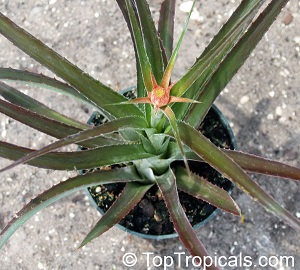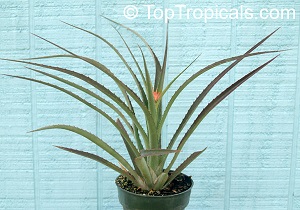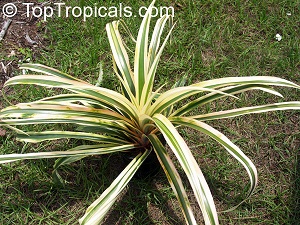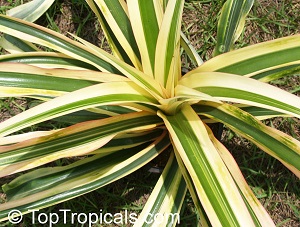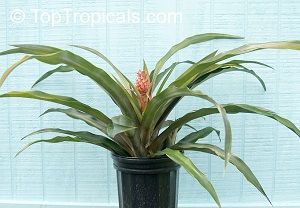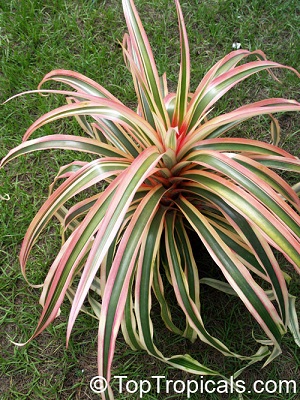Pineapple Varieties There are numerous pineapple varieties, however, 'Smooth Cayenne' is one of the most common variety grown. Other varieties which may be difficult to find for planting include 'Red Spanish', 'Singapore Spanish', 'Green Spanish', 'Sugarloaf', and 'Queen'. There are many variants of these pineapple varieties. More recently several new varieties have been developed and released including 'Delmonte Gold' and 'MD2'. 1 'Red Spanish' 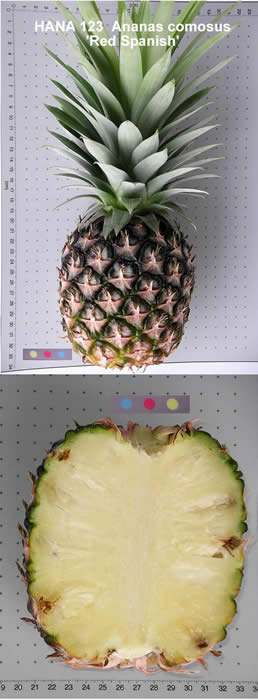 Fig. 1 'Red Spanish' Not as widely available as 'Smooth Cayenne'. Leaves are spiny. Fruit weigh 2 to 4 lbs and have a pale yellow flesh with pleasant aroma. Fruit have a squarish shape. Well adapted for shipping as fresh fruit to distant markets. Leaves spiny. 1 'Singapore Spanish' 'Singapore Red' (Also called 'Red Jamaica', 'Singapore Spanish', 'Singapore Queen', 'Singapore Common') is second to 'Mauritius' in popularity. The leaves are usually all-green but sometimes have a reddish stripe near the margins; they are rarely spiny except at the tips. The fruits, cylindrical, reddish, with deep eyes, are small—3 1/2 to 5 lbs (1.6-2.25 kg)—with slender core, fibrous, golden-yellow flesh; insipid raw but valued for canning. The plant is disease and pest-resistant. The related 'Green Selangor' (also called 'Selangor Green', 'Green Spanish', and 'Selassie') of Malaysia has all-green leaves prickly only at the tips. The flesh is golden-yellow, often with white dots. This cultivar is grown for canning. 2 'Smooth Cayenne' This is the variety from Hawaii, and the most easily obtainable in U. S. grocery stores. 1 'Smooth Cayenne' or 'Cayenne', 'Cayena Lisa' in Spanish (often known in India, Sri Lanka, Malaysia and Thailand as 'Sarawak' or 'Kew') was selected and cultivated by Indians in Venezuela long ago and introduced from Cayenne (French Guyana) in 1820. From there it reached the Royal Botanical Gardens, Kew, England, where it was improved and distributed to Jamaica and Queensland, Australia. Because of the plants near freedom from spines except for the needle at the leaftip and the size-4 to 10 lbs (1.8 4.5 kg)-cylindrical form, shallow eyes, orange rind, yellow flesh, low fiber, juiciness and rich mildly acid flavor, it has become of greatest importance worldwide even though it is subject to disease and does not ship well. Mainly, it is prized for canning, having sufficient fiber for firm slices and cubes as well as excellent flavor. 2 It was the introduction of this cultivar into the Philippines from Hawaii in 1912 that upgraded the Philippine industry from the casual growing of the semi-wild type which was often seedy. There are several clones of 'Smooth Cayenne' in Hawaii which have been selected for resistance to mealybug wilt. It is the leading cultivar in Taiwan. In 1975, the Queensland Department of Primary Industries, after 20 years of breeding and testing, released a dual purpose cultivar named the 'Queensland Cayenne'. South Africas Pineapple Research Station, East London, after 20 years of selecting and testing of 'Smooth Cayenne' clones, has chosen 4 as superior especially for the canning industry. 2 'Queen' Not as widely available as 'Smooth Cayenne'. Leaves are spiny. Fruit weigh 2 to 3 lbs and have a golden yellow flesh, crisp texture and delicate mild flavor. Keeps well after ripening. 1 'Queen' (also called 'Common Rough' in Australia) is the leading cultivar in South Africa, Queensland and the Philippines. The plant is dwarf, compact, more cold-resistant and more disease-resistant then 'Smooth Cayenne'. It matures its fruit early but suckers freely and needs thinning, and the yield is low. The fruit is conical, deep-yellow, with deep eyes; weighs 1 to 2 1/2 lbs (0.45-1.13 kg); is less fibrous than 'Smooth Cayenne', but more fragrant; it is juicy, of fine flavor with a small, tender core. It is sold fresh and keeps well. It is only fair for canning because of its shape which makes for much waste. 2 'Sugarloaf' 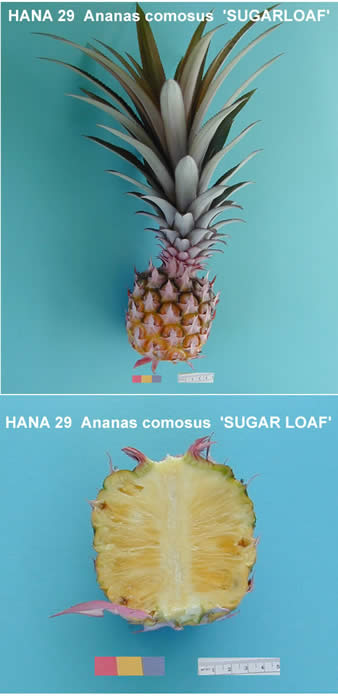 Fig. 2 'Sugarloaf' 'Sugarloaf' (also called 'Pan de Azucar') is closely related to 'Abacaxi', and much appreciated in Central and South America, Puerto Rico, Cuba and the Philippines. The leaves of the plants and crowns pull out easily and this fact gave rise to the unreliable theory that pineapple ripeness is indicated by the looseness of the leaves. The fruit is more or less conical, sometimes round; not colorful; weighs 1 1/2 to 3 lbs (0.68-1.36 kg). Flesh is white to yellow, very sweet, juicy. This cultivar is too tender for shipping. 2 Super sweet types These new varieties may not be available from nurseries. There are a number of new super sweet pineapple varieties with various names including 'Del Monte Gold™ Extra Sweet' (also called MD-2), this new pineapple variety is very sweet and has a barrel-like appearance. The pulp has a deep gold/yellow color inside. 'Hawaiian Gold'™, 'Super Sweet'™ and 'Ultra Sweet'™ are other new super sweet varieties. These new varieties can be picked and shipped and retain good fruit quality. 1 Assorted
Visit the repository collection of pineapples at the Tropical Plant Genetic Resources and Diseases Reseach USDA ext. link Back to Pineapple Page |
||||||||||||||||||
| Bibliography 1 Crane, Jonathan. "Pineapple Growing in the Florida Home Landscape." edis.ifas.ufl.edu. One of a series of the Horticultural Sciences Department, Florida Cooperative Extension Service, Institute of Food and Agricultural Sciences, University of Florida. Original publication 1975. Re-written Oct. 2006. Revised November 2016. Reviewed Dec. 2019. Accessed 2 Mar. 2017, 13 Apr. 2020. 2 Fruits of Warm Climates. Julia F. Morton, Miami, 1987. Photographs Fig. 1,2 'Red Spanish' and 'Sugarloaf. N.d. USDA, ARS, National Genetic Resources Program. Germplasm Resources Information Network - (GRIN) [Online Database]. National Germplasm Resources Laboratory, Beltsville, Maryland. ars.usda.gov. Web. 14 Oct. 2014. Fig. 3,4,5,6,7,8,9,10,11 Anonas comosus. N.d. Top Tropicals Tropical Plant Catalog. toptropicals.com. Web. 14 Oct. 2014. Published 26 Dec. 2013 LR. Last update 13 Apr. 2020 LR |
||||||||||||||||||
